Cool Ways to Draw Bubble Letters
How to depict chimera messages
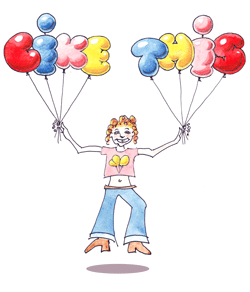
Why does a calligrapher demand to know how to describe bubble messages? They're fun. They're like shooting fish in a barrel. You can draw them anywhere with just a pencil, or a biro, and a little color. They're useful for signs, doodles, cartoons, posters, altogether cards and so forth. And they're very simple to decorate.
And so here is the Calligraphy Skills 'How to Draw Bubble Letters' complimentary online tutorial. This is my own alphabet design. Information technology shows how to draw bubble letters based on a circle, and so they really BULGE. It's bones, but it works.
The instructions are not in alphabetical order but proceed more or less from the simpler letters to the more than complicated. The images come first, then notes containing more than information on how to draw the bubble letters. I've likewise grouped messages according to like forms. If you first at the beginning and work through, you'll learn the whole Calligraphy Skills bubble alphabet. Or simply find whatsoever particular letters y'all want and only learn those.
The order is:
(this page)O Q I ... D B ... C V U ... A H
(page 2)S Z Due north ... E M W ... P R F
(folio 3)Y T ... 1000 L Ten ... J M
How to draw chimera letters, step by pace
You'll need:
• a pencil – I apply a 2H for construction lines and a 3 or 4B for concluding outer lines, and for shading if I'yard shading in pencil
• a good eraser
• paper
• some kind of colour if you desire to color the letters in – if so, brand sure your paper is high enough quality to accept it because it'south frustrating to draw the perfect alphabet on cheap photocopy paper and and so detect your watercolour paint is running and blotching all over the place or the chalk pastel won't stick
• compasses (if you are a precise-minded blazon) to depict the circles, or else something circular to describe around or trace ... I began by cartoon circular a small plastic pot-lid but the reward of using compasses is that the point leaves that fiddling hole so you can always easily find the centre of the circumvolve equally a starting-signal for constructing the balance of the alphabetic character
Fix? :-) Start by lightly drawing a circle in pencil. This is your 'construction circle'.
Information technology's useful to mark a small-scale dot in the heart of the circle, as a guide while forming many of the messages.
And here we become with O and Q:
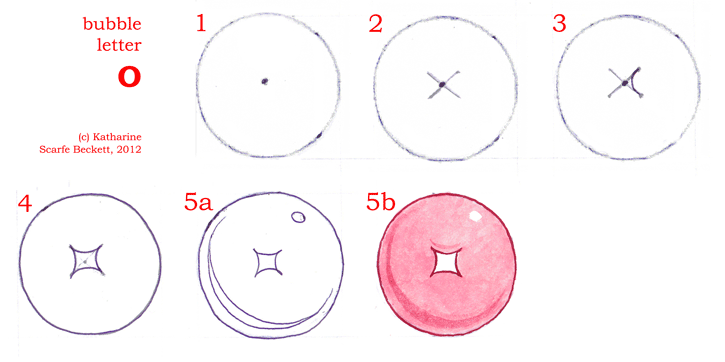
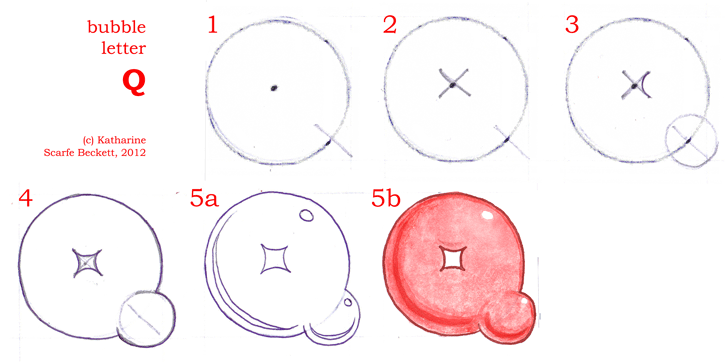
O, Q
Both these are already by and large drawn for you in the form of the original circle. For both O and Q, find the middle of the circumvolve and on information technology draw a modest, regular 10. Join the points of the 10 with short, curved lines bulging inwards. That's O. Now, for Q, sketch in a small-scale circle towards the lesser right of the letter of the alphabet (directly contrary the bottom-correct betoken of the little 'star' you drew in the eye). It should straddle the outer line of the original construction circumvolve. Erase the inner pencil lines. Black-pencil or ink over the final lines, inside and out. You're washed. Like shooting fish in a barrel-peasy. Side by side!
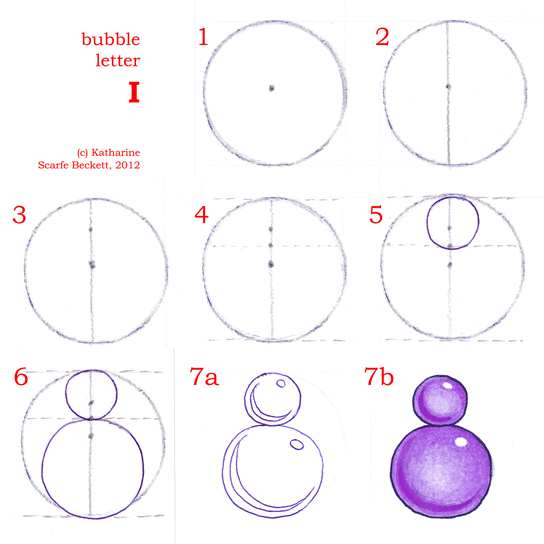
I
I is also based on the uncomplicated circumvolve merely it'due south slightly different from O and Q: it'southward ii circles, a large i at the bottom which should exist well-nigh 2-thirds the size of your original construction circle, and a second littler circle on top. (I started with a dissimilar manner of drawing 'I' which you can come across in the illustration higher up. It worked for a while only somewhen I decided it looked also fiddly and not bubbly enough, and so I redesigned the alphabetic character for this simpler form.)
On to D and B!
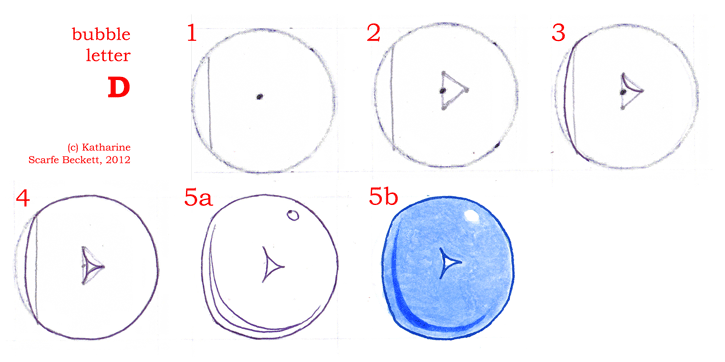
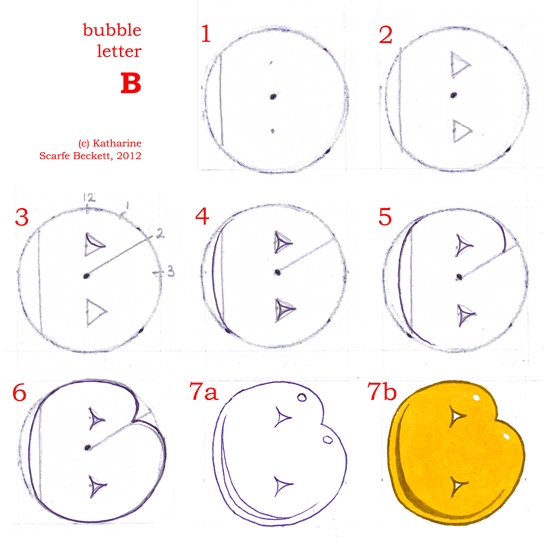
D, B
These two messages take direct backs in almost ordinary alphabets. Afterward thinking for a long time well-nigh how to draw bubble letters with long straight lines in them, I decided that the all-time way to assist the eye recognise the letter of the alphabet is to utilize a long shallow curve instead. Then first draw in the straight back as a vertical line, and and then draw a curve that falls exactly halfway between that vertical and the full-circular curve of your original construction circumvolve.
Annotation that the counter or white space inside these two letters is based on a triangle, unlike O and Q which use a four-sided lozenge. This helps the eye sympathize the underlying form of the letter and recognise it for like shooting fish in a barrel reading even though it is distorted towards a circumvolve.
The residuum of the details (I hope) should be obvious from the analogy. The 'B' is non every bit complicated as it looks. You could guess past center to draw in the short diagonal line that divides its two lobes. I show a simple manner of finding a like position for information technology repeatedly, in case you lot are drawing multiple 'B's in the same stretch of text. Imagine the circle is a clock-face, and draw the line from 2 o'clock to the centre.
Ready for C, V and U? They employ divider-lines in an even more than exciting way than B. If y'all really desire to know how to describe bubble messages, then you're about to learn a very interesting technique ... Oh, the suspense :-)
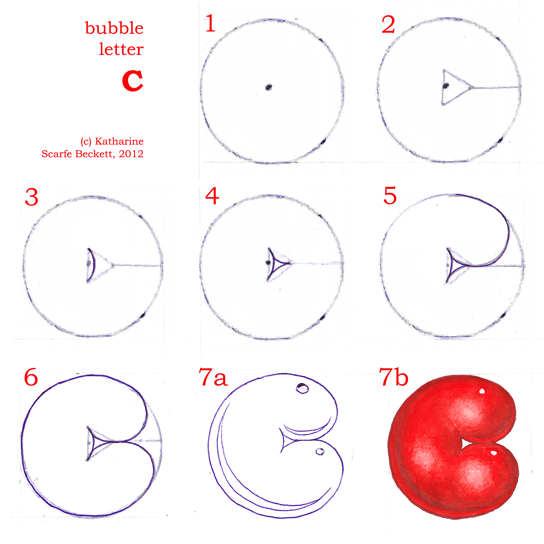
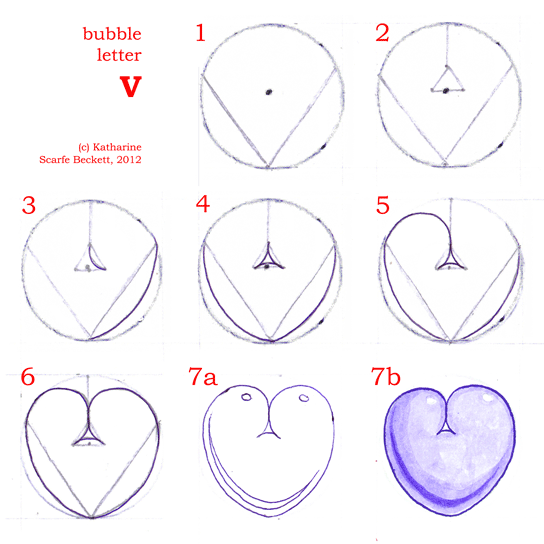
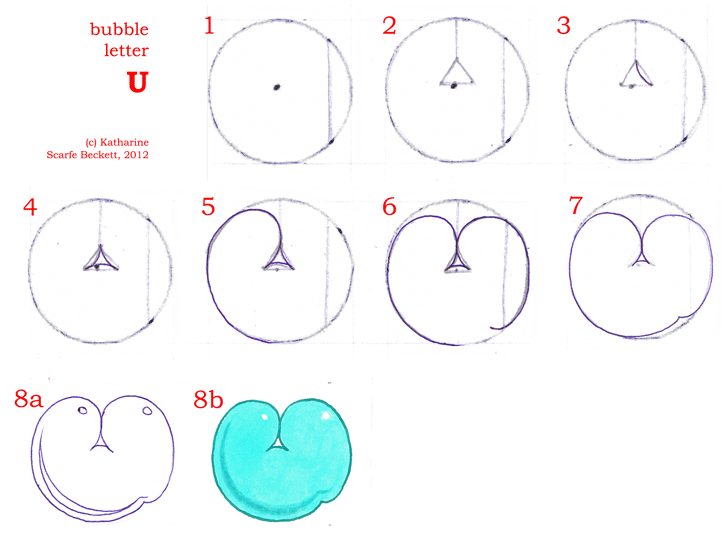
C, V, U
(By at present you volition accept noticed that my images are different sizes according to whether there are three or 4 letterforms in the rows. Aye it is adventitious. No I have not had time to correct them all and re-upload them. It was late at dark in Photoshop, I was tired, etc etc. Sorry.)
The style the dividing lines work in these letters is important to grasp so that you know how to draw bubble letters that look fully inflated but not squashed. When yous depict the curves from the inside triangle, make sure (a) that they extend smoothly into the rest of the letter and (b) that they only but impact the dividing line at one signal. If they run along the dividing-line, they will make the letter look pressed-together, and a flake odd. If they don't touch at all, the letter won't look every bit round and bubbly as it could.
Of class, if you desire to alter that rule deliberately to create your own upshot for a new alphabet, that's different. Go right ahead!
The C has some ersatz reflected-light highlights added – the paler patches reverse the highlights, on the 'undersides' of the curves. Crude, only I sort of similar it.
In theory you could create merely ane alphabetic character, a kind of slightly pointy curvy matter with no right-hand 'leg', that would represent both 'V' and 'U', the mode the Romans did with monumental and rustic capitals. I prefer to have two split messages since this is a modernistic alphabet.
Now for A! And H! Aha!
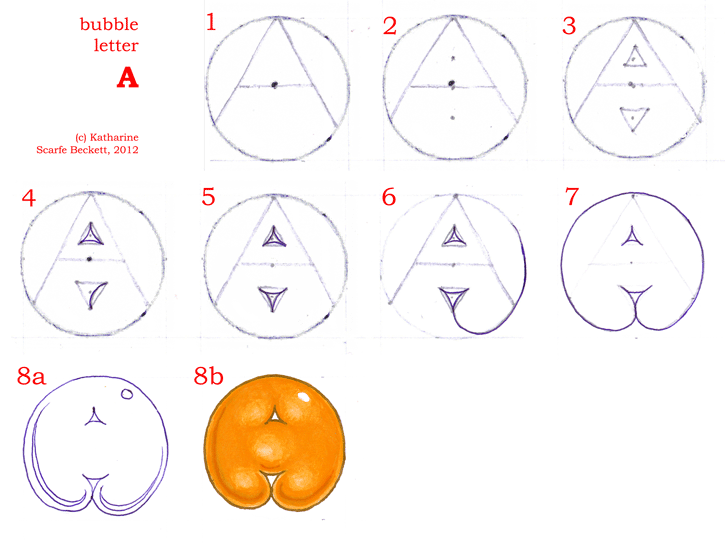
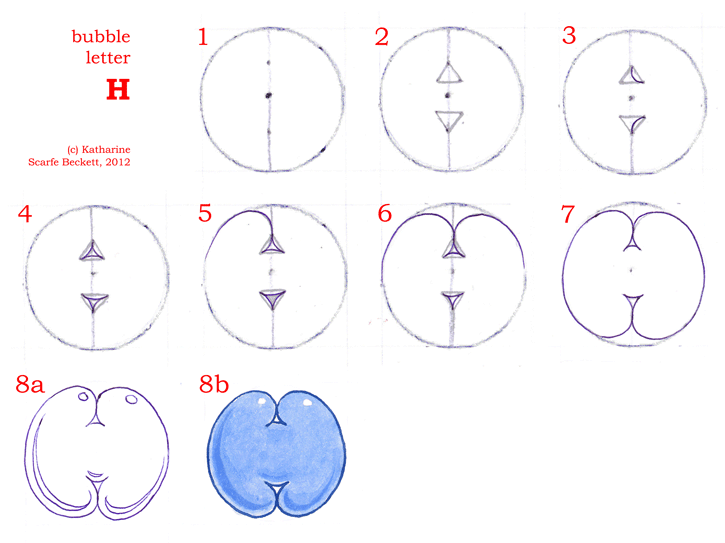
A, H
(More than reflected-light highlights on the A. I was having fun.)
These 2 letters are fairly simple to work out one time yous have grasped the basic principle of dividing the circumvolve and drawing internal curves that but bear upon each other. As you can see, an H is just an A with another dividing line at the top.
Based on D and B, you might think it would make sense to employ long, shallow curves to represent the longer directly lines of 'A' and 'H', instead of letting them follow the original fatter curve of the construction circumvolve. All the same, I think these ii letters remain very recognisable with circular sides, and bubblier that manner. As information technology's all about how to draw chimera letters, non totally consistent letters, it seems best to go along information technology uncomplicated.
Next upwards on the second page are South Z North ... E M W ... P R F.
(Y T ... K Fifty X ... J K are on the third page.)
A little background
I didn't originally intend to write a tutorial on how to draw chimera letters. Notwithstanding, I just couldn't find a free bubble alphabet online that I really liked for the site. 'Bubble' to me means the letter has to exist a round shape, practically spherical. Similar a bubble!
So I started cartoon my own letters to testify visitors what I meant ... then I noticed some useful rules emerging for how to course similarly-shaped letters ... adjacent thing I knew I'd designed my ain version of a bubble alphabet and was drawing little step-by-footstep instructions for visitors to bear witness them how I'd done it and how they could reproduce it (and redesign it of course).
The final forms higher up are all presented fairly similarly (ie 1 colour per letter of the alphabet, highlights top right, crescent-shaped shading) then you can see that it's a coherent alphabet. However, I've varied the colours and textures of the shading. Partly that's to help give an idea of how the letters look using different effects. Partly it's to encourage you to colour your own the mode you want them to look. And it was more fun that way, too :-)
Designing your own alphabet is a lot of fun. I recommend it! Feel free to use this page equally you wish for personal and educational purposes, and of course use it to inspire your ain alphabet designs. Delight don't sell the instructions or images. Equally their creator I intend for them to be available for no accuse.
Get to 'How to Draw Chimera Letters two' (S Z N ... E M W ... P R F)
Become to 'How to Draw Bubble Letters 3' (Y T ... K L X ... J G)
Return to 'Bubble Letters' (full general overview, and other links)
Render from 'How to Draw Chimera Letters' to the homepage
Source: https://www.calligraphy-skills.com/how-to-draw-bubble-letters.html
0 Response to "Cool Ways to Draw Bubble Letters"
Postar um comentário